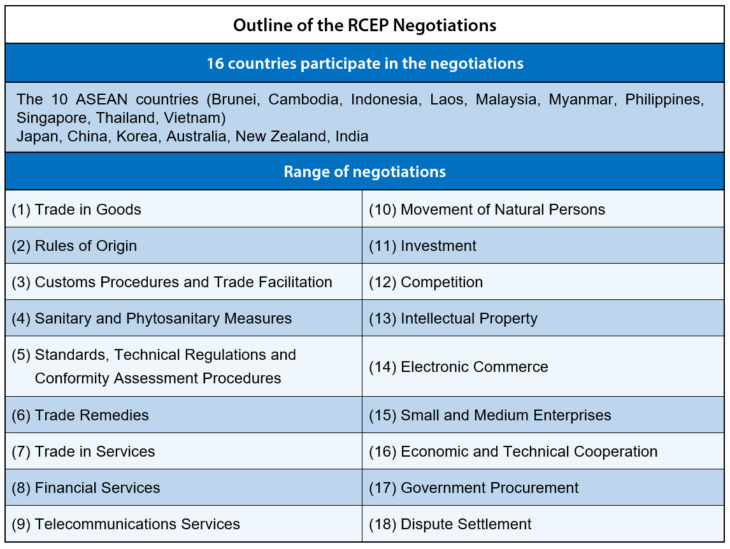Prospects for the RCEP Negotiations: Japan and ASEAN Are Key to a Conclusion Within the Year
Key Points:
- Implementing the RCEP would greatly benefit the global economy.
- Deter protectionism together with the TPP and the Japan-EU EPA
- Transitional measures and capacity-building support the negotiation conclusion

Prof. Shimizu Kazushi
On July 1, Tokyo hosted a ministerial meeting of the Regional Comprehensive Economic Partnership (RCEP). This was the first ministerial meeting to be held outside the Association of Southeast Asian Nations (ASEAN).
RCEP is a supra-regional economic area (a mega free trade agreement) in East Asia, the center of global economic growth. The sixteen nations participating in the negotiations account for about half of the world’s population (3.4 billion) while the GDP (about USD 20 trillion) and total trade (about USD 10 trillion) account for one third globally. If the agreement is implemented, it will have a substantial and positive impact on both the East Asian and the global economy.
Regional cooperation in East Asia has developed with the focus on the ASEAN and the five ASEAN Plus One free trade agreements (FTA) with Japan, China, and Korea among others. But Japan and China were at loggerheads over an East Asia-wide FTA so it was not possible to start negotiations.
However, the United States joined the Trans-Pacific Partnership (TPP) negotiations amid shifting circumstances in the wake of the global financial crisis of 2008. As a result, the ASEAN proposed the RCEP in November 2011. This was the first move toward a mega FTA in East Asia.
At the first ASEAN Economic Ministers Plus ASEAN Partners consultations in August 2012, sixteen nations agreed to implement the RCEP. A ceremony to launch negotiations was held in November 2012 and the first negotiation meeting took place in May 2013. It was not possible to come to a conclusion during 2015 as initially planned, but the RCEP negotiations accelerated when the TPP was agreed in October 2015. The ASEAN Economic Community (AEC) was established in December 2015.
Let us verify the content of the RCEP. According to the 2012 Guiding Principles and Objectives for Negotiating the RCEP, the objective of the RCEP is to achieve a modern, comprehensive, high-quality and mutually beneficial economic partnership agreement among the sixteen nations. The document also specifies that negotiations will recognize ASEAN centrality.
Aiming for an FTA that improves on the ASEAN Plus One free trade agreements, the RCEP will also promote trade and investment, and support the international supply chain. The document also mentions special treatment and a flexible approach to the least-developed ASEAN members in consideration of the different stages of development in the participating countries. These stipulations are a major feature that distinguishes the RCEP from the TPP and other partnerships.
The three pillars of the RCEP are market access, rules, and cooperation. The negotiations cover eighteen broad areas. (See table.)
The effects of the RCEP are, firstly, to promote investment and the trade in goods and services across East Asia, and to contribute to further economic development in every country amid the rapid expansion in exports and investment ongoing since the latter half of the 1980s. Secondly, to contribute to developing rules for trade and commerce. The rules for each FTA will be consolidated and rules for new fields such as intellectual property and e-commerce will be developed. Under the current global trading system, the World Trade Organization (WTO) does not always function satisfactorily so it is essential for any mega FTA to prepare new rules for trade and commerce.
Thirdly, to support the development of production networks and supply chains in East Asia. The rapid growth in East Asia is underpinned by an international division of labor that straddles all manufacturing countries. The existing five ASEAN Plus One FTAs will be bundled in with the RCEP to form an East Asia-wide FTA, and it is likely that there will be further improvements to production networks. Fourthly, the RCEP has the potential to contribute to reducing the economic gap between the developed and developing countries in the region.
Implementation of the RCEP is extremely important for the Japanese economy and Japanese corporations. In 2017, the countries participating in the RCEP accounted for approximately 49% of Japan’s total trade and the volume is rising with every year. The RCEP, which includes the ASEAN, Japan, China, Korea and India, is highly compatible with the production networks of Japanese corporations. Finished goods and components, as well as intermediate goods circulate among the RCEP participants. As well as promoting trade and investment, the RCEP will bring in new rules for trade facilitation, intellectual property rights, and electronic commerce—measures which are expected to provide substantial support for the activities of Japanese corporations.
However, when President Trump took office in January 2017, he withdrew from the TPP causing major changes in the situation around the RCEP. The TPP had pushed to deepen the AEC and to accelerate the RCEP negotiations, and it seemed likely that the new TPP rules would have a knock-on effect on the RCEP. But when the United States pulled out, it became difficult for the TPP to back RCEP negotiations. The goal had been to wrap up the RCEP negotiations in the course of 2017, but it was not possible to bridge the differences between the nations on the rules and the trade liberalization and other market access, so no agreement was reached.
At present, protectionism and trade friction, initiated by the United States, is once again rocking the global economy. If the United States raises tariffs and other countries impose retaliatory tariffs, it is possible that protectionism will once again spread worldwide. The expansion of protectionism would be a major blow to East Asia which has developed amid expanding trade and investment.
With the TPP in deadlock, Japan proposed the TPP-11 in May 2017 and the TPP-11 agreement was signed on March 8, 2018. Japan has also gone ahead with a mega FTA with the European Union (EU), finalizing the deal in December 2017. In a situation where protectionism is expanding, the RCEP together with the TPP-11 and the Japan-EU EPA will become a major force for reversing global protectionism.
Comprising vastly diverse countries, the RCEP negotiations are beset with difficulties. The countries range from Australia and New Zealand, which are demanding a high level of liberalization of the trade in goods, to India, which is extremely negative to liberalization. Australia, Japan and Korea demand high quality rules for intellectual property and electronic commerce whereas China and India do not. To conclude the negotiations, it will be necessary to support capacity-building and to recognize transitional measures for liberalization and rules in some countries.
ASEAN plays an important role in the negotiations. The proposal for the RCEP originated with the ASEAN, which is also leading the negotiations. The objectives stipulate ASEAN centrality and the sectoral working groups are chaired by the ASEAN countries. The ASEAN meets prior to the RCEP meetings to consolidate their negotiations stance. It is highly significant that the ASEAN is leading on the mega FTA in East Asia unlike the Belt and Road Initiative, the supra-regional economic plan promoted by China.
The 22nd round of the RCEP negotiations was held in Singapore from April 28 to May 8. The March signatories to the TPP-11 back the RCEP negotiations. Singapore, which is a keen supporter of the FTA and the chair of ASEAN in 2018, is making strong efforts to conclude the negotiations. According to the parties involved, the negotiations are making progress despite the complexities in each sector. In addition to the areas of economic and technical cooperation, and small and medium enterprises, the other areas are also heading for agreements. However, depending on the country, politically sensitive areas will require more discussion.
The ministerial meeting in Tokyo on July 1 was jointly chaired by Japan and Singapore. With the recent expansion in protectionism, it is desirable to secure high-quality market access and rules, and to bring the RCEP to a conclusion as soon as possible. Opposed to protectionism, Japan plays an important role promoting the three mega FTA; i.e., the TPP-11, the RCEP and the Japan-EU EPA. In cooperation with ASEAN, Japan should guide the RCEP negotiations toward a conclusion during this year. The RCEP will make a significant difference to global economic prospects.
Translated by The Japan Journal, Ltd. The article first appeared in the “Keizai kyoshitsu” column of The Nikkei newspaper on 20 June 2018 under the title, “RCEP Kosho no Yukue I: Nennai daketsu, Nichi-ASEAN kagi (Prospects for the RCEP Negotiations I: Japan and ASEAN Are Key to a Conclusion Within the Year).” The Nikkei,20 June 2018. (Courtesy of the author)
Keywords
- RCEP
- mega FTA
- protectionism
- ASEAN
- AEC
- TPP-11
- Japan-EU EPA
- WTO

